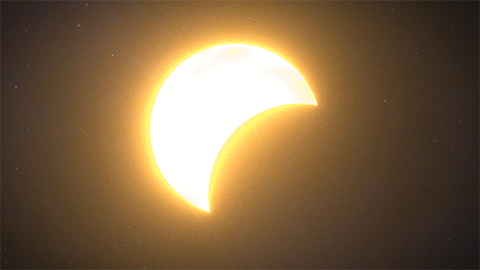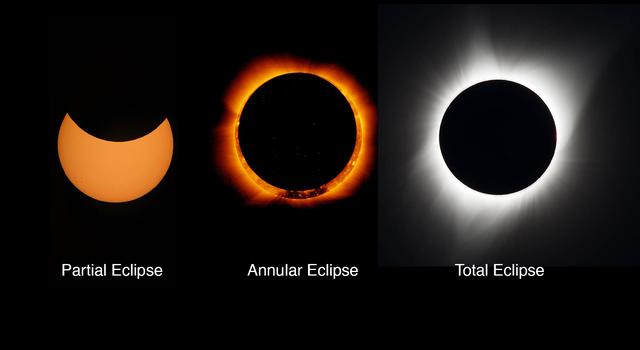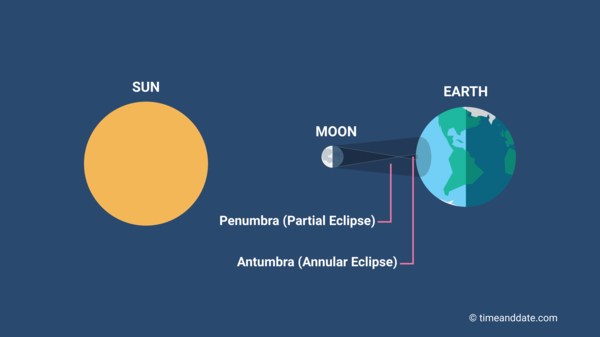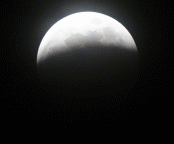Announcements
UPDATE: All the Year Two lessons have been posted. If you have already done some assignments in the old version, you can do them in the revised version.
Lesson 3) 2.3 Syzygies and Eclipses
2.3: Syzygies and Eclipses
Syzygy Types
Good evening, students, and welcome back to Astronomy. During the previous lesson, I mentioned the concept of a syzygy. What do you recall about this celestial event? Yes, a syzygy is an event that occurs when three astronomical bodies line up with each other. Remember in the case of spring tides, we are talking about the Sun, Earth, and the Moon (though we rarely get true syzygies during most full and new Moons for reasons that will be explained a little later). But a syzygy can also be an alignment of two planets and a moon, two moons and a planet, or any combination of three astronomical bodies. In fact, syzygies involving Jupiter and its four Galilean moons are quite common due to Jupiter’s size and the relative nearness of its moons. For this reason, we will be using many Jovian (or Jupiter-centric) examples to explore the three types of syzygies: transits, occultations, and eclipses.
The image below shows Jupiter’s innermost moon, Io, transiting Jupiter. Note that you can see Io’s shadow on Jupiter’s clouds in addition to Io in front of the planet.
Transit: Io Transits Jupiter
Source: here
When a smaller astronomical body moves in front of a larger astronomical body, this event is called a transit. Please note that in the definitions in this section, the words “smaller” and “larger” refer to angular size from one’s point of view, rather than physical size! While this sometimes aligns with the bodies’ physical sizes, that’s not always the case, as you will shortly see. Also, when referring to transits, the correct way to convey this information is by using the format “smaller body transits larger body” to avoid confusion.
Now, with that out of the way, during a transit, you should be able to see the larger body behind the smaller body. Please note that since the picture above happens to be taken from a Muggle spacecraft, and since the spacecraft is not an astronomical body, it is not technically a syzygy. However, if the picture had been taken from Earth, such a transit would show a syzygy between Earth, Io, and Jupiter.
If you’ve ever seen or heard of Mercury or Venus passing the sun, this is another example of a transit, since the respective planet is directly between the Sun and Earth!
On the opposite side of the syzygy spectrum, when a larger astronomical body moves in front of a smaller astronomical body, the event is called an occultation. During an occultation, you are only able to see the larger body, as the smaller body is hidden behind it, but just before the occultation, you can see both bodies. The image below shows the moment before Jupiter is occulted by the Moon. When referring to occultations, be sure to use the format “smaller body is occulted by larger body.” With all these different kinds of syzygies to keep track of, terminology is crucial to not getting mixed up! Jupiter is the smaller object (by angular size, not physically) in the upper right corner, while the Moon is the larger object in the middle. Since this image was taken from Earth, the occultation of Jupiter by the Moon also resulted in a syzygy between Earth, the Moon, and Jupiter.

Occultation: Just Before Jupiter is Occulted by the Moon
Source: here
Finally, we reach the last kind of syzygy: an eclipse. An eclipse occurs when the shadow of one astronomical body falls on all or part of another one. This type of syzygy is one between the body casting the shadow, the body the shadow is being cast on, and some sort of luminous object, usually the Sun. If you’ll refer back to the first image we looked at today, the one of Io transiting Jupiter, you can see Io’s shadow on the gas giant. Because of that shadow, we can also say that a wee bit of Jupiter is being eclipsed by Io.
Interestingly, eclipses can also go the other way! The shadow casting body can also be said to eclipse the luminous object if your point of view is flipped. Looking at our previous example, from the viewpoint of an observer on Jupiter in Io’s shadow, Io is eclipsing the Sun. When we talk about eclipses seen from Earth, we are usually talking about solar eclipses and lunar eclipses. I will talk a little about both in this lesson, as it is important to know the differences between them.
Solar and Lunar Eclipses from Earth
Daily Prophet Article on an Eclipse
Source: here
A solar eclipse occurs only when the Moon is new, and a lunar eclipse occurs only when the Moon is full, but neither of them occurs every time the moon is in the correct phase, because the Moon’s orbit is inclined to Earth’s orbit by about five degrees. You see, the Moon’s orbit intersects the plane of Earth’s orbit in two places called nodes, and an eclipse occurs only if the Moon is on or near one of its nodes.

Nodes of the Moon's orbit
Source: here
Because of this, a lunar eclipse occurs about twice a year and a solar eclipse between two and five times a year. If you want to know more about the frequency of eclipses, you can find information about it here.
Solar Eclipse

A Total Solar Eclipse
Source: here
A total solar eclipse is an example of an occultation. During a solar eclipse, the Moon moves in between Earth and the Sun. When seeing a total solar eclipse from Earth, we see the Moon covering all but the corona, also known as the atmosphere, of the Sun. You can see this in the image above. Partial and annular solar eclipses are also possible. In these cases, the Moon does not completely block out the Sun, but does still pass in front of it and obscures it slightly!
What do you see over the course of a solar eclipse? When the Moon begins to pass between Earth and the Sun, you see a portion of a black circle start to “take a bite” out of the Sun; the edges of the black part are somewhat hazy at first. The bite then grows bigger and bigger as the Moon moves to fully block the Sun. Just before you get to full coverage, you see an interesting phenomenon called “Baily’s beads.” This fascinating event is when the Sun is still visible just around the edges of the Moon, as bits of the Sun are still shining from between the Moon’s mountains, though not always evenly. Eventually, when only one “bead” is visible, the effect looks like a diamond ring. Finally, you see the Sun totally covered except for the corona. At this point in the eclipse, the temperature drops a few degrees, and some animals and birds behave the way they would at night. When the Moon makes its exit, you get to see all of the previous steps in reverse.

Baily’s Beads Diamond Ring Effect
Source: here
Now, how is this possible? As we know, the Sun is far bigger than the Moon. However, it’s also much farther away from Earth by about the same amount, so the two bodies have roughly the same angular size as viewed from Earth: about half a degree. The reason they both vary is because Earth’s orbit and the Moon’s orbit are ellipses instead of circles. Therefore, if Earth is at aphelion (or the point where it is farthest from the Sun) and the Moon is at perigee (or the point at which it is closest to the Earth), the Moon looks a bit bigger than the Sun, so it’s able to totally block the Sun from view, and an observer in the Moon’s shadow sees a total eclipse.
During an eclipse, as Earth rotates about its axis, the Moon’s shadow traces a narrow path along Earth’s surface called “the path of totality.” To see a total eclipse, you have to be in that path, and the maximum duration of totality is about seven minutes. Eclipse enthusiasts sometimes travel thousands of kilometres just to see it, and they’re often disappointed because clouds block their view; so, if you want to observe a total eclipse, check the weather forecast at every place in the path of totality. Outside of the path of totality, you can only see a partial eclipse, where the Moon does not completely cover the Sun.
If Earth is at perihelion and the Moon is at apogee, then the Moon looks a bit smaller than the Sun. An eclipse during this time is what is called an annular eclipse, because a ring of sunlight shines around the black circle that is the Moon. Below is an image of the three types of solar eclipse.

The three types of solar eclipses
Source: here
As you can see in the image below, there are three main parts of the Moon’s shadow during an annular eclipse of the Sun: the penumbra, the umbra (not labelled), and the antumbra. The penumbra is the part of shadow where most of the light from the Sun is blocked by the Moon, but not all of it, resulting in a little chunk of it appearing on one side. The umbra is the part where the Moon completely blocks the light from the Sun, but during an annular eclipse, the umbra doesn’t reach Earth. Finally, the antumbra is the most interesting part of the shadow in a solar eclipse, as the Moon is for the most part still directly between this area of Earth and the Sun, but some light still sneaks around on all sides due to the distance and relative sizes of the Moon and the Sun.

The Moon's Antumbra
Source: here
Lunar Eclipse

Total Lunar Eclipse
Image Source: here
During a lunar eclipse, Earth’s shadow covers the view of the full Moon. In other words, a lunar eclipse is a syzygy between the Sun, Earth, and the Moon with Earth in the middle. A total lunar eclipse is often distinguished by its characteristic red colour, as seen in the picture above. In this situation, the shadow of Earth completely falls over the Moon. Partial lunar eclipses are also possible when the Sun, Earth, and the Moon are not completely aligned.
Now, before we dive into what you see during a lunar eclipse, I want to give you a quick overview of the parts of the shadow during an eclipse.
With all of that in mind, you can imagine that a lunar eclipse looks different while the Moon is in different parts of Earth’s shadow. While the Moon is in the penumbra, you may notice a very gradual darkening of the Moon, but nothing dramatic happens until a bit of the Moon enters the umbra. That is when you see part of a dark circle start to block part of the Moon, which then grows until it covers the whole Moon. The duration of totality is about an hour or two before the circle gradually uncovers the Moon. In a most fascinating turn of events, the Moon looks reddish during a lunar eclipse because the dust and water droplets in Earth’s atmosphere scatter sunlight. Blue and violet light scatter more than red light, so the red light that isn’t scattered bends around Earth and bathes the Moon. The specific colour varies slightly and can be tinged gold or dark grey depending upon the condition of the atmosphere. If it’s red, it is sometimes called a blood Moon.
Magic Matters
Having presented some information about eclipses available to Muggles, we turn the topic to information that only we magical people have access to! Solar and lunar eclipses have a profound effect on the amount of solar and lunar magic, respectively, that reaches Earth. Briefly, during a solar eclipse, some of the Sun’s magic is blocked by the Moon from reaching part of Earth’s surface. You can imagine that there are significant impacts of this change! Similarly during a lunar eclipse, Earth blocks some solar magic from reaching the Moon, so there is less of it to be reflected back to Earth. We will discuss both cases separately in detail.
Solar Eclipse
We’ll start with a solar eclipse. During a solar eclipse, solar magic is reduced, but even during a total eclipse, plenty of it still reaches Earth, thanks to the corona that peeks around the Moon. Don’t think that this is an excuse to try to look at the Sun through your telescope though! Even the minimal magic that comes through via the corona is enough that it will still destroy the charms on the von Rheticus telescope. As for the effect of a solar eclipse on the performance of magic on Earth, studies show that less magic is performed during periods of a total eclipse than at other times, leading to speculation that the decreased amount of sunlight reaching Earth makes it harder to do magic. But magic is practised at night, when even less sunlight reaches Earth. How is that possible? Our bodies naturally adjust to the variance in solar magic through the day/night cycle. They therefore store a little extra magic during the day to be utilised at night. They’re used to that slow ebbing and flowing of solar magic, however during an eclipse, the relatively quick change in the amount of solar magic causes a bit of a magical shock to the system. Since our bodies are actively absorbing and using that power while the Sun is shining, the sudden loss of it can cause us to lose our magical footing, so to speak, and make spellcasting more difficult.
Lunar Eclipse
Now, you may remember that I mentioned the exciting colour shift during total lunar eclipses. The red colour is quite striking – and completely harmless – but you wouldn’t believe the crazy superstitions and beliefs that Muggles and early witches and wizards had about these eclipses because of their colour and its ominous associations. They were often quite dramatic.
The truth of the matter is that, during a lunar eclipse, lunar magic is decreased, and the more of the Moon that is in the umbra of Earth’s shadow, the less lunar magic reaches Earth. As a result, it is safe to watch a lunar eclipse through your von Rheticus telescope as long as at least half of the Moon is darkened.
Also, when the Moon is eclipsed, lunar magic interferes less with that reaching us from the planets (of course, for any interference to occur, both the Moon and the planet must be above the horizon). Those planets that are closer than 90 degrees from the Moon in the sky enjoy constructive interference from the Moon, but there’s less of it if the Moon is eclipsed, so we get less of their magic, whereas for those planets that are farther than 90 degrees from the Moon, there is less destructive interference from the Moon, so we get more of their magic. How can you tell the angular distance between the Moon and a planet? To get an accurate measurement you could use a tool called a sextant (you can learn more about those here), but an approximate measurement can be made using your hand, as we discussed in Lesson Three last year!
This is ultimately a bit of a let-down in comparison to thinking that Dark magic, necromancy, or poisons will be more potent at this time, I know. However, it bears reminding you that each of these planets has its own type of magic, so there are quite a lot of effects to consider! For example, if Mars’s interference is decreased, you might find curses a bit weaker or more short-lived, since, as you remember from First Year, Mars is highly related to stubbornness, combat, and battles. Though, as mentioned, these changes are slight, and most people will never notice the subtle nuances.
Tips for Eclipse Watchers
If you want to watch an eclipse, please refer to this source, where you can see when and where to view future solar and lunar eclipses. When you do view a solar eclipse, be sure to do so only through indirect means, like projecting the image of the Sun through a pinhole onto a piece of paper, or else use a proper solar filter. Looking at the Sun with your naked eye will damage your retina within a few seconds! The light from the corona isn't powerful enough to damage your eyes, and in fact, you can't see the corona through a solar filter, but as soon as any part of the Sun's surface becomes visible, you mustn't look at it except through a solar filter. Similarly, looking at the Sun through any telescope will blind you instantly unless a solar filter is attached to the objective lens. If you attach it to the eyepiece, the sunlight will be focussed on the filter and the heat could crack it, blinding you!
Unfortunately a solar filter has no effect on solar magic, so don’t look at the Sun through your magical telescope even during an eclipse. On the other hand, neither your eyes nor your telescope are in any danger from a lu … oh, there I go repeating myself! I must be getting tired. I’d better terminate this lesson now before you get too tired to write the quiz and the essay.
The original lesson was written by Professor Turing
Part of this lesson was written by Professor Plumb
- ASTR-101
Enroll
-
ASTR 2.3 [Essay] Breaking News
Essay -
2.3: Eclipses
Quiz
-
Velinea Nite
Head Student
-
Timothy Walsh
Professor's Assistant
-
Velinea Nite
Professor's Assistant
-
Alex Halsey
Professor's Assistant
-
Namikah Hunt
Professor's Assistant


